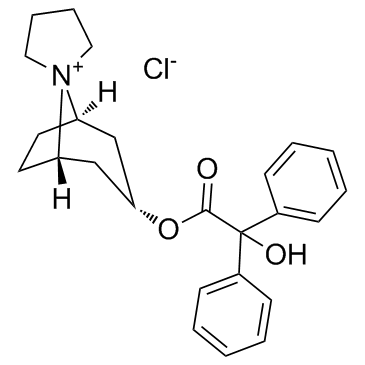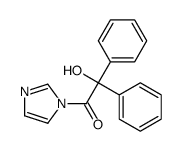Trospium Chloride

Trospium Chloride structure
|
Common Name | Trospium Chloride | ||
|---|---|---|---|---|
| CAS Number | 10405-02-4 | Molecular Weight | 392.510 | |
| Density | N/A | Boiling Point | N/A | |
| Molecular Formula | C25H30ClNO3 | Melting Point | 266-268ºC | |
| MSDS | N/A | Flash Point | N/A | |
| Symbol |

GHS07 |
Signal Word | Warning | |
Use of Trospium ChlorideTrospium Chloride is a competitive muscarinic cholinergic receptor antagonist.Target: mAChRTrospium chloride is an antimuscarinic agent indicated for the treatment of overactive bladder with symptoms of urge urinary incontinence, urgency, and urinary frequency. Trospium has pharmacologic properties that are distinct from other antimuscarinic agents [1]. After oral administration, absorption of the hydrophilic trospium chloride is slow and incomplete. Peak plasma concentrations (Cmax) of approximately 4 ng/mL are reached 4-5 hours after administration of a 20 mg immediate-release preparation. The mean bioavailability is approximately 10% and decreases by concomitant food intake (to a mean of 26% of the fasting area under the plasma concentration-time curve [AUC]). Trospium chloride displays dose proportional increases in AUC and Cmax after a single dose within the clinically relevant dose range (20-60 mg). The mean volume of distribution is approximately 350-800 L [2]. |
| Name | Trospium Chloride |
|---|---|
| Synonym | More Synonyms |
| Description | Trospium Chloride is a competitive muscarinic cholinergic receptor antagonist.Target: mAChRTrospium chloride is an antimuscarinic agent indicated for the treatment of overactive bladder with symptoms of urge urinary incontinence, urgency, and urinary frequency. Trospium has pharmacologic properties that are distinct from other antimuscarinic agents [1]. After oral administration, absorption of the hydrophilic trospium chloride is slow and incomplete. Peak plasma concentrations (Cmax) of approximately 4 ng/mL are reached 4-5 hours after administration of a 20 mg immediate-release preparation. The mean bioavailability is approximately 10% and decreases by concomitant food intake (to a mean of 26% of the fasting area under the plasma concentration-time curve [AUC]). Trospium chloride displays dose proportional increases in AUC and Cmax after a single dose within the clinically relevant dose range (20-60 mg). The mean volume of distribution is approximately 350-800 L [2]. |
|---|---|
| Related Catalog | |
| References |
| Melting Point | 266-268ºC |
|---|---|
| Molecular Formula | C25H30ClNO3 |
| Molecular Weight | 392.510 |
| Exact Mass | 392.222015 |
| PSA | 46.53000 |
| LogP | 0.70 |
| InChIKey | RVCSYOQWLPPAOA-DHWZJIOFSA-M |
| SMILES | O=C(OC1CC2CCC(C1)[N+]21CCCC1)C(O)(c1ccccc1)c1ccccc1.[Cl-] |
| Storage condition | -20?C Freezer |
| Water Solubility | Very soluble in water, freely soluble in methanol, practically insoluble in methylene chloride. |
CHEMICAL IDENTIFICATION
HEALTH HAZARD DATAACUTE TOXICITY DATA
|
| Symbol |

GHS07 |
|---|---|
| Signal Word | Warning |
| Hazard Statements | H302 |
| Precautionary Statements | P301 + P312 + P330 |
| Hazard Codes | Xi |
| RIDADR | NONH for all modes of transport |
| RTECS | WH1424000 |
|
~75% 
Trospium Chloride CAS#:10405-02-4 |
| Literature: Krebs, Andreas; Schaefer, Bernd; Kochner, Arno Patent: US2010/48903 A1, 2010 ; Location in patent: Page/Page column 11 ; |
| Precursor 2 | |
|---|---|
| DownStream 0 | |
|
New strategies for medical management of overactive bladder in children.
Curr. Opin. Urol. 20(4) , 313-7, (2010) The medical treatment of children with non-neurogenic overactive bladder syndrome (OAB) is still limited to a small number of drugs approved for use in childhood according to the national regulations ... |
|
|
What is the success of drug treatment in urge urinary incontinence? What should be measured?
Arch. Gynecol. Obstet. 287(3) , 511-8, (2013) The aim of this study is to evaluate the efficacy and the tolerability of three classic antimuscarinic drugs used in the treatment of over active bladder syndrome using clinical data and quality of li... |
|
|
Benefits and harms of pharmacologic treatment for urinary incontinence in women: a systematic review.
Ann. Intern. Med. 156(12) , 861-74, W301-10, (2012) Urinary incontinence (UI) in women adversely affects quality of life.To conduct a systematic literature review of drugs for urgency UI in women.MEDLINE, the Cochrane Central Register of Controlled Tri... |
| Spasmex |
| Relaspium |
| Trospium Chloride |
| Trospium (chloride) |
![(1R,5R)-3-Hydroxyspiro[bicyclo[3.2.1]octane-8,1'-pyrrolidin]-1'-ium chloride structure](https://image.chemsrc.com/caspic/168/3464-71-9.png)


